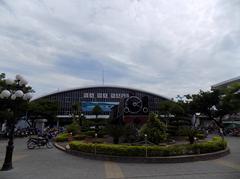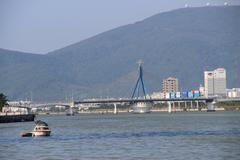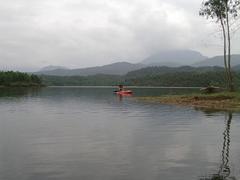Visiting Hours and Tickets for Suối Lương in Da Nang
Date: 23/07/2024
Introduction: Discover the Beauty of Suối Lương
Nestled in the vibrant city of Da Nang, Vietnam, Suối Lương is a remarkable site that offers an exquisite blend of historical richness, cultural depth, and natural beauty. Originally inhabited by the indigenous Cham people, Suối Lương is steeped in history dating back to the 2nd century AD. The Cham civilization, renowned for its advanced maritime skills and significant role in the spice trade, left an indelible mark on the region’s architectural and cultural landscape (UNESCO). The remnants of Hindu temples and intricate carvings of deities like Shiva and Vishnu offer a window into the spiritual life of the Cham people (Vietnam Tourism) and continue to attract history enthusiasts and cultural explorers alike.
The French colonial period further shaped Suối Lương, introducing Western architectural styles and infrastructure developments that facilitated easier access to this enchanting locale (Lonely Planet). Today, Suối Lương stands as a testament to Vietnam’s rich heritage, offering visitors a unique opportunity to immerse themselves in both its natural splendor and historical grandeur. With the Vietnamese government’s efforts to promote sustainable tourism, Suối Lương has become a top destination for tourists seeking a harmonious blend of history, culture, and nature (Vietnam National Administration of Tourism).
This comprehensive guide aims to equip potential visitors with all the essential information needed to make the most of their visit to Suối Lương. From visiting hours and ticket prices to travel tips and cultural insights, this guide covers everything you need to know.
Table of Contents
- Introduction
- Historical Background
- Modern Era and Tourism Development
- Unique Features and Activities
- Cultural Significance and Preservation Efforts
- FAQ
- Conclusion
Exploring Suối Lương - History, Cultural Significance, and Visitor Information in Da Nang
Historical Background
Early History and Indigenous Influence
Suối Lương, located in Da Nang, Vietnam, is a site rich in historical significance and cultural heritage. The area was originally inhabited by the indigenous Cham people, who established a thriving civilization in Central Vietnam from the 2nd century AD. The Cham people were known for their advanced maritime skills and their role in the spice trade, which brought them into contact with various cultures, including Indian, Chinese, and Arab traders. This cultural exchange is evident in the architectural and artistic remnants found in the region, such as the nearby Mỹ Sơn Sanctuary, a UNESCO World Heritage site (UNESCO).
The Cham Kingdom and Hindu Influence
The Cham Kingdom, which flourished from the 2nd to the 15th century, left a lasting impact on the region surrounding Suối Lương. The Cham people practiced Hinduism, and their religious beliefs are reflected in the temples and sculptures that dot the landscape. The influence of Hinduism is particularly evident in the intricate carvings and statues of Hindu deities found in the area. These historical artifacts provide a glimpse into the spiritual life of the Cham people and their devotion to gods such as Shiva and Vishnu (Vietnam Tourism).
The Decline of the Cham Kingdom
The decline of the Cham Kingdom began in the 15th century due to a series of conflicts with the expanding Đại Việt (Vietnamese) kingdom to the north. The Đại Việt eventually conquered the Cham capital of Vijaya in 1471, leading to the assimilation of the Cham people into Vietnamese society. Despite this, the Cham culture and heritage continued to influence the region, including areas like Suối Lương. The remnants of Cham architecture and cultural practices can still be observed today, offering a unique historical perspective for visitors (Asia Society).
French Colonial Period
During the French colonial period in the late 19th and early 20th centuries, Da Nang, including Suối Lương, underwent significant changes. The French established Da Nang as a major port city, which led to the development of infrastructure and the introduction of Western architectural styles. This period also saw the construction of roads and railways that connected Da Nang to other parts of Vietnam, facilitating easier access to areas like Suối Lương. The French influence is still visible in some of the colonial-era buildings and structures that remain in the region (Lonely Planet).
Modern Era and Tourism Development
In the modern era, Suối Lương has transformed into a popular tourist destination, known for its natural beauty and historical significance. The Vietnamese government has invested in developing the area to attract both domestic and international tourists. Efforts have been made to preserve the historical and cultural heritage of the region while promoting sustainable tourism practices. Visitors to Suối Lương can explore the lush landscapes, enjoy the serene environment, and learn about the rich history that has shaped this unique destination (Vietnam Tourism).
Visitor Information
Visiting Hours and Tickets
Suối Lương is open to visitors daily from 8:00 AM to 6:00 PM. Ticket prices are affordable, with a standard entry fee of VND 50,000 for adults and VND 30,000 for children. Discounts are often available for groups and during special events.
Travel Tips and Accessibility
Suối Lương is easily accessible by road from Da Nang city center. Public transportation options include buses and taxis, with ample parking available for those driving. The site is well-maintained with pathways that are suitable for visitors of all ages and abilities. It is recommended to wear comfortable walking shoes and bring water, especially during the hotter months.
Unique Features and Activities
Special Events and Festivals
Suối Lương hosts various traditional festivals and cultural events that celebrate the heritage of the Cham people and the broader Vietnamese culture. These events provide an opportunity for visitors to experience traditional music, dance, and cuisine, offering a deeper understanding of the local culture.
Guided Tours and Photographic Spots
Guided tours are available and highly recommended to fully appreciate the historical context and significance of Suối Lương. The site also offers numerous picturesque spots perfect for photography, capturing both the natural beauty and historical architecture.
Cultural Significance and Preservation Efforts
The cultural significance of Suối Lương extends beyond its historical roots. Preservation efforts are ongoing to protect the historical sites and natural environment of Suối Lương, ensuring that future generations can continue to appreciate its rich heritage. Community-based tourism initiatives involve local residents in promoting and preserving the cultural heritage of the area, providing them with economic opportunities while ensuring the site’s integrity (Vietnam National Administration of Tourism).
Archaeological Discoveries
Recent archaeological discoveries in and around Suối Lương have shed new light on the region’s historical significance. Excavations have uncovered artifacts such as pottery, tools, and religious objects that date back to the Cham period. These findings provide valuable insights into the daily life, trade practices, and religious beliefs of the Cham people. The ongoing research and excavation efforts highlight the importance of Suối Lương as a site of historical and archaeological interest (Archaeology Magazine).
Integration with Local Communities
The integration of Suối Lương with the local communities has been a key factor in its development as a tourist destination. Local residents play an active role in promoting and preserving the cultural heritage of the area. Community-based tourism initiatives have been established to involve local people in the tourism industry, providing them with economic opportunities while ensuring that the cultural and environmental integrity of Suối Lương is maintained. These initiatives have been successful in creating a sustainable tourism model that benefits both visitors and the local community (Responsible Travel).
FAQ
Q: What are the visiting hours for Suối Lương?
A: Suối Lương is open daily from 8:00 AM to 6:00 PM.
Q: How much are the tickets for Suối Lương?
A: Standard entry fee is VND 50,000 for adults and VND 30,000 for children.
Q: Are there guided tours available?
A: Yes, guided tours are available and recommended to fully appreciate the site’s historical context.
Q: How can I get to Suối Lương?
A: Suối Lương is easily accessible by road from Da Nang city center, with options for public transportation and ample parking available.
Conclusion
Suối Lương’s historical background is a tapestry of indigenous Cham culture, colonial influences, and modern development. Its rich history and cultural significance make it a fascinating destination for tourists seeking to explore Vietnam’s heritage. The ongoing preservation efforts and community involvement ensure that Suối Lương remains a vibrant and sustainable tourist destination for years to come.
For more updates and travel tips, be sure to follow us on social media and check out our mobile app Audiala.
References
- UNESCO World Heritage Centre. (n.d.). My Son Sanctuary. https://whc.unesco.org/en/list/949/
- Vietnam Tourism. (n.d.). https://vietnam.travel/
- Lonely Planet. (n.d.). https://www.lonelyplanet.com/
- Vietnam National Administration of Tourism. (n.d.). https://vietnamtourism.gov.vn/
- Asia Society. (n.d.). https://asiasociety.org/
- Responsible Travel. (n.d.). https://www.responsibletravel.com/





